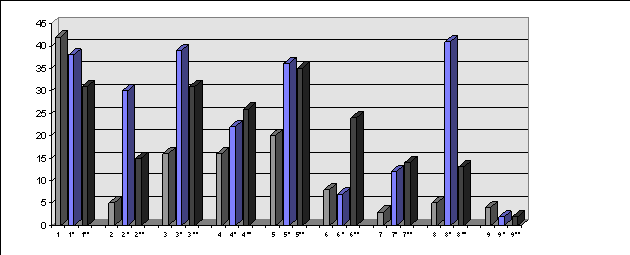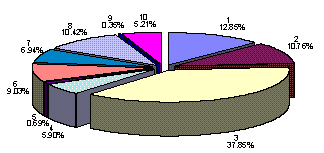
Induced mutations and their application in genetic improvement of pea
| Mehandjiev, A., Noveva, S. and Kosturkova, G. | Institute of Genetics |
Induced mutations have played an important role in the genetic improvement of cultivated plants. Physical and chemical mutagenesis of pea has produced genotypes with higher productivity (1, 6, 8), altered flowering and maturation characteristics (4, 5, 7), powdery mildew resistance (2), and higher protein content (3). In this study we investigate the possibility of generating mutations to improve the architecture, productivity and protein content of peas.
Mutagen factors used in the experiments were: i)
g-rays generated by 60Co source in four rates (from 40 rad/min to 6457 rad/min), ii) the chemical mutagens ethyl methane sulphonate (EMS), diethyl sulphate (DS), or ethylene imine (EI), iii) combined treatment ( g-rays + chemical mutagens). Gamma-rays at doses from 50 Gy to 100 Gy were applied with two rates - high (1860 rad/min) and low (49 rad/min). Fast neutrons at doses 500-1000 rad were applied in two rates (23.5 rad/min and 4.6 rad/min) as well. Eighteen varieties of forage pea and two varieties of garden pea were treated with these mutagens. Leaf and stem mutations were identified in the M2. Special attention was paid to mutations with potential commercial value such as those producing larger number of pods and seeds, higher protein content, lodging resistance, and shorter vegetation period. Mutation frequency was defined as number of mutants per 100 M2 plants.Mutants with higher seed weight have been created by
g-irradiation and DS treatment (Table 1). Mutants II/132, VII/98, XV/122 exceed the initial varieties in seed productivity and in absolute (seed) weight (with exception of XV/122). Mutants with short stems (from 33 to 76 cm ) were created from the tall (105 cm) variety Ramonski 77 (Table 2). These mutants, especially I/132, I/34 and I/30, have a larger number of pods and seeds with mutant I/32 being particularly outstanding, having 55 seeds compared to 39 in the control. Table 1. Seed weight of stem mutants generated by various mutagensVarieties, mutants |
Mutagen |
Mean seed weight [g] |
Mean total seed weight per plant [g] |
Ramonski-77 |
7.79 |
205 |
|
Mutant I/12 |
g -rays 50 Gy3 |
8.19 |
190 |
Mutant I/126 |
g -rays 50 Gy1 |
9.04 |
200 |
Roman, |
7.87 |
245 |
|
Mutant II/127 |
DS 0.2 % |
9.21 |
256 |
Mutant II/132 |
g -rays 50 Gy2 |
14.36 |
270 |
Voronejzki |
10.25 |
261 |
|
Mutant VII/98 |
g -rays 50 Gy4 |
13.41 |
270 |
Auralia |
10.94 |
276 |
|
Mutant XV/122 |
g -rays 75 Gy5 |
13.15 |
247 |
Rate:
1 40 rad/min; 2 1351 rad/min; 3 1725 rad/min; 4 2000 rad/min; 5 6457 rad/min Table 2. Elements of productivity of stem mutations (mean values from a period of 4-5 years)Varieties, mutants |
|
Period [years] |
Height, [cm] |
Number |
Number |
Ramonski-77 |
4 |
105 |
11.60 |
39.94 |
|
Mutant I/31 |
g -rays 200 Gy* |
4 |
47 |
14.26 |
55.75 |
Mutant I/32 |
“ |
4 |
47 |
12.45 |
50.56 |
Mutant I/33 |
“ |
4 |
45 |
12.33 |
49.31 |
Mutant I/34 |
“ |
4 |
46 |
14.69 |
54.63 |
Mutant I/35 |
“ |
4 |
33 |
13.85 |
47.72 |
Mutant I/30 |
“ |
5 |
76 |
16.02 |
48.42 |
* Rate 2000 rad/min
Combined treatment of seeds with
g-rays and EMS generated mutants with higher protein content from cv. Kubrat-3. Table 3 presents mutants with protein content from 30.1% to 32.6% compared to control of 22.8%. These mutant lines maintain statistically proved higher protein content for 5 to 6 generations and have been used in breeding programs to create the garden pea variety ‘Sredetz’ , which shows higher productivity, higher protein and vitamin C content. Table 3. Protein content in obtained mutant pea lines
|
Protein
content [mg] |
Protein
content |
relative to
control |
| Kubrat-3 | Initial variety | 22.77 |
100.00 |
| 781 | Thicker wax layer | 30.53 |
134.07 |
| 782 | Fertile, large pods | 31.78 |
139.57 |
| 787 | Fertile, large seeds | 31.91 |
140.14 |
| 794 | Waxless pods | 30.13 |
132.32 |
| 795 | Fertile, waxless | 31.08 |
136.49 |
| 808 | Fertile, thicker wax layer | 30.13 |
132.32 |
| 809 | Thicker wax layer | 32.18 |
141.32 |
| 823 | Higher productivity | 32.59 |
143.12 |
In addition some mutant lines (N 781, 809, 823) are characterized by a thicker wax layer. Because of the lower transpiration a thicker cuticle can be very useful for drought tolerance, having been used to create forms resistant to the early spring drought characteristic for the Bulgarian climatic conditions.
A critical aspect of the experimental mutagenesis is the efficiency of the treatment (number of indexed mutations per treatment). Fig 1. presents the type and number of induced mutations in plant architecture as a function of mutagen treatment. To better evaluate the effectiveness of the mutagen treatment, mutations were grouped in three categories: productive, sterile and lethal. Our results indicate that the frequency of productive stem mutations is considerably higher when
g-rays are given at the higher rate. At the lower rate (49 rad/min) sterile forms dominate. When fast neutrons are used the frequency of fertile mutants did not change with irradiation rate. However, a lower rate of fast neutrons appeared to favor lethal mutants, whereas the higher rate generated more sterile mutants. When chemical mutagens were applied most of the mutations in plant architecture were sterile or lethal (see treatments 5, 6, and 7 in Figure 1). The EMS treatment gave significantly more fertile mutants than the DS and EI treatment. The combined treatment generated mostly sterile mutations.

Fig 1. Type and number of stem mutations depending on mutagen
treatment: (1) g-rays at rate 1860 rad/min; (2) g-rays at rate 49 rad/min; (3) fast neutrons at rate
23.5 rad/min; (4) fast neutrons at rate 4.6 rad/min; (5) EMS 0.1 %; (6) DS 0.1 %; (7) EI
(0.01 %; (8) combined mutagens; (9) spontaneous.
fertile mutants; *sterile; **lethal
The type of stem mutations observed is presented in Fig. 2. The highest percentage is represented by dwarf mutations (37.9%) followed by mutations with elongated internodes (12.8%) and finally mutations with reduced height (10.8%). The Fasciata (bole habit) mutation is of special interest for mechanical harvesting of pea. Dwarf forms might provide more lodging resistance.

Fig 2. Stem mutations: (1) elongated internodes; (2) reduced height by 50-60%; (3) dwarfs; (4) thicker stem; (5) alternation of short and long internodes; (6) Fasciata semi bole habit; (7) Fasciata bole habit; (8) Fruticosa; (9) Horisontalis; (10) branched habit.
1. Gottschalk, W. 1966. In Mutations in Plant Breeding, Int. Atom. Ener. Agency, Vienna, p. 85.
2. Gottschalk, W. and Kaul, M.L.H. 1980. Theor. Appl. Genet., 56:71-79.
3. Gottschalk, W., and Wolff, G. 1983. In Biochemistry, Genetics, Nutritive, Value. Eds. W. Gottschalk and H.P. Muller, Martinus Nihoff, The Hague, Netherlands, p. 403.
4. Kaul, M.L.H. 1997. Curr. Sci., 46:198.
5. Knavel, D.E. 1967. J. Hered., 58:78-80.
6. Siderova, K.K., 1969, Agrobiology, p. 4, 538.
7. Sidorova, K.K. and Uzhinseva, L.P. 1974. Itogi Nauch Rabot, Inst. Tsitolog. Genet. Otd. AN SSSR, Novosib., p. 49.
8. Vassileva, M. 1978. In Experimental Mutagenesis in Plants. Sofia,p. 440.